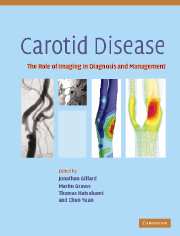Book contents
- Frontmatter
- Contents
- List of contributors
- List of abbreviations
- Introduction
- Background
- Luminal imaging techniques
- Morphological plaque imaging
- 14 MR plaque imaging
- 15 CT plaque imaging
- 16 Assessment of carotid plaque with conventional ultrasound
- 17 Assessment of carotid plaque with intravascular ultrasound
- 18 Image postprocessing
- Functional plaque imaging
- Plaque modelling
- Monitoring the local and distal effects of carotid interventions
- Monitoring pharmaceutical interventions
- Future directions in carotid plaque imaging
- Index
- References
15 - CT plaque imaging
from Morphological plaque imaging
Published online by Cambridge University Press: 03 December 2009
- Frontmatter
- Contents
- List of contributors
- List of abbreviations
- Introduction
- Background
- Luminal imaging techniques
- Morphological plaque imaging
- 14 MR plaque imaging
- 15 CT plaque imaging
- 16 Assessment of carotid plaque with conventional ultrasound
- 17 Assessment of carotid plaque with intravascular ultrasound
- 18 Image postprocessing
- Functional plaque imaging
- Plaque modelling
- Monitoring the local and distal effects of carotid interventions
- Monitoring pharmaceutical interventions
- Future directions in carotid plaque imaging
- Index
- References
Summary
Introduction
Stroke is the most common cause of disability in adults in Western societies. Infarction and ischemia account for 80% of all strokes and about 20–30% of ischemic stroke can be linked to carotid artery stenosis (Caplan, 1991). The degree of carotid luminal stenosis is used in therapeutic decision-making: patients with symptomatic or asymptomatic carotid stenosis above a certain degree are considered candidates for carotid intervention, such as carotid endarterectomy or stent placement.
However, the fact that most symptomatic patients have only mild stenotic lesions and that most patients with severe carotid stenosis are asymptomatic (North American Symptomatic Carotid Endarterectomy Trial Collaborators, 1991; Randomised trial of endarterectomy, 1998), show that apart from the degree of stenosis, other features may play a role in an acute ischemic event and in the assessment of stroke risk.
Morphology studies on carotid and coronary atherosclerotic plaque have lead to the consensus opinion that atherosclerotic plaque morphology and luminal plaque surface could be these important features (Naghavi et al., 2003). An atherosclerotic plaque with specific morphological features (e.g. a large lipid core with a thin fibrous cap; outward remodeling) is more prone to rupture, and irregular luminal plaque surfaces (caused by ruptured or eroded plaques) are more prone to thrombus formation, thromboembolization and consequent acute events (Figure 15.1) (Naghavi et al., 2003).
Because computerized tomography angiography (CTA) can accurately grade the severity of carotid luminal stenosis (Koelemay et al., 2004) computerized tomography (CT) is increasingly used in the evaluation of stroke patients.
Keywords
- Type
- Chapter
- Information
- Carotid DiseaseThe Role of Imaging in Diagnosis and Management, pp. 191 - 207Publisher: Cambridge University PressPrint publication year: 2006



